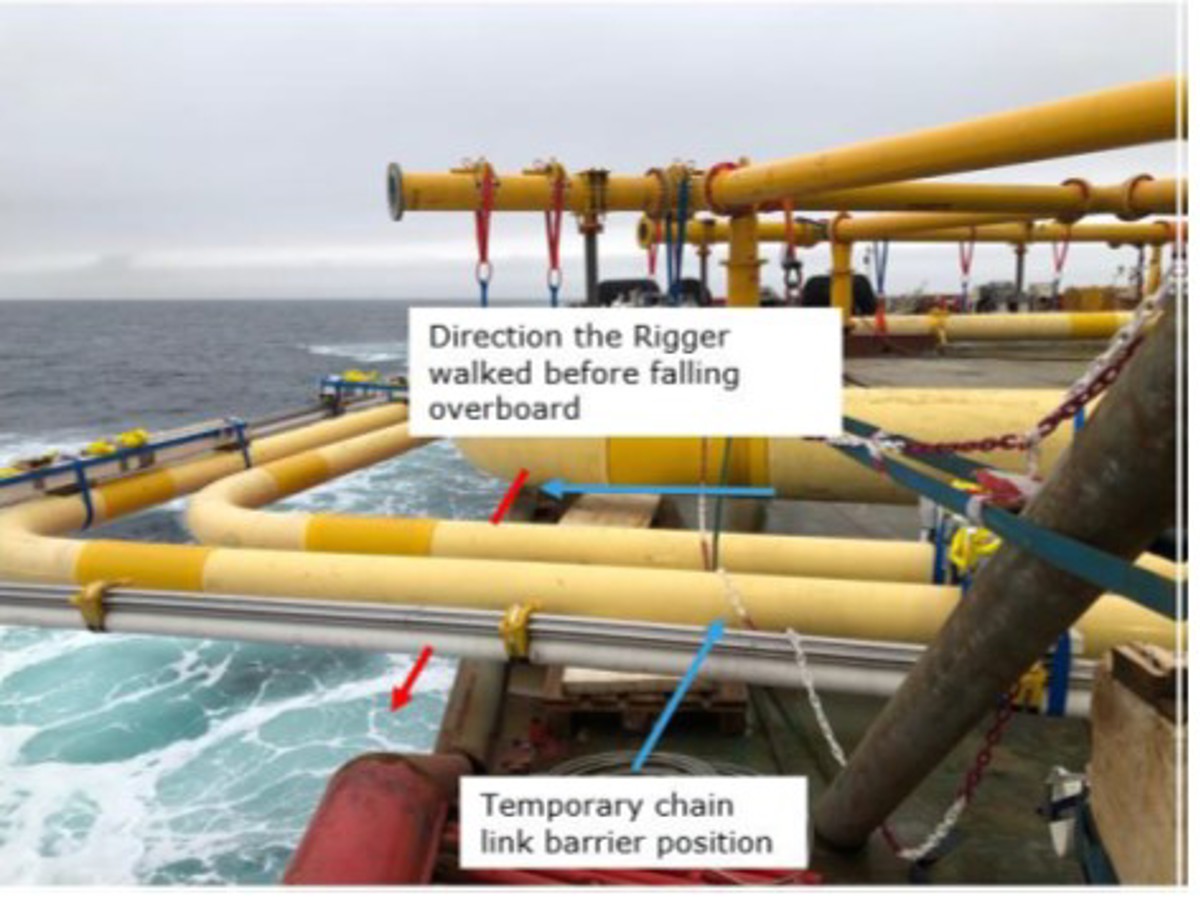Man overboard incident (not fatal)
- Safety Flash
- Published on 6 December 2020
- Generated on 5 July 2025
- IMCA SF 33/20
- 3 minute read
Jump to:
What happened?
A man overboard incident occurred, in port at night. A rigger on the main deck, walking around spools secured to the main deck, stepped off the side of the vessel and fell to the sea.
During mobilisation of large spools, the vessel crew had removed a section of the starboard bulwark to accommodate the spools, for they were bigger than the main deck area – the spools extended over the side of the vessel.
During sea-fastening of the spools a rigger decided to walk around the outside of the largest spool (see picture), without realising this was over the side of the vessel. The rigger passed through a chain barrier and subsequently stepped over the side of the vessel. The rigger was not observed falling, but his calls for help were heard.
He was rescued unharmed through the effective response of his colleagues, using life buoys and the pilot ladder.

What were the causes?
- No rigid barriers were erected at the time of incident, only a temporary chain barrier, which the rigger passed through.
- Darkness, shadows, light transitions and poor weather (drizzle) made it difficult to see the difference between the deck and the water.
- The rigger had been on board for two weeks (with the bulwarks removed throughout that period due to multiple spool sets being mobilised) and had participated in the toolbox talk before he started work. He still did not understand the full hazard.
- There was no explicit specification that gaps should be barriered off on the starboard side (the task plan did specify a barrier for a similar situation on port side of the vessel).
Actions
- Verify that all temporary gaps and openings which create a fall hazard are equipped with rigid barriers.
- Never use access control barriers (plastic chain or barrier tape) as the single barrier for fall protection hazards.
- Review appropriateness of the use of access control barriers in particular:
- only using these barriers for access control and not for control of fall hazards
- warning signs used with the barrier
- authorisation of access and egress from the barriered area.
- Check that back deck lighting is sufficient, with particular reference to areas of deep shadow.
- When project activities involve the removal or disabling of permanent safety equipment on a worksite, such as bulwarks, handrails and fire detectors for example, the project team has a responsibility to plan for an alternative and equally effective means of protection, confirming this with the worksite.
Members may wish to refer to
- LTI – rigger tripped over quayside obstacle in the dark and fell
- LTI – Feet trapped in motion compensated telescopic gangway [one immediate cause: There was insufficient lighting on the gangway]
- Fatality – Man overboard [during the hours of darkness]
IMCA Safety Flashes summarise key safety matters and incidents, allowing lessons to be more easily learnt for the benefit of the entire offshore industry.
The effectiveness of the IMCA Safety Flash system depends on the industry sharing information and so avoiding repeat incidents. Incidents are classified according to IOGP's Life Saving Rules.
All information is anonymised or sanitised, as appropriate, and warnings for graphic content included where possible.
IMCA makes every effort to ensure both the accuracy and reliability of the information shared, but is not be liable for any guidance and/or recommendation and/or statement herein contained.
The information contained in this document does not fulfil or replace any individual's or Member's legal, regulatory or other duties or obligations in respect of their operations. Individuals and Members remain solely responsible for the safe, lawful and proper conduct of their operations.
Share your safety incidents with IMCA online. Sign-up to receive Safety Flashes straight to your email.